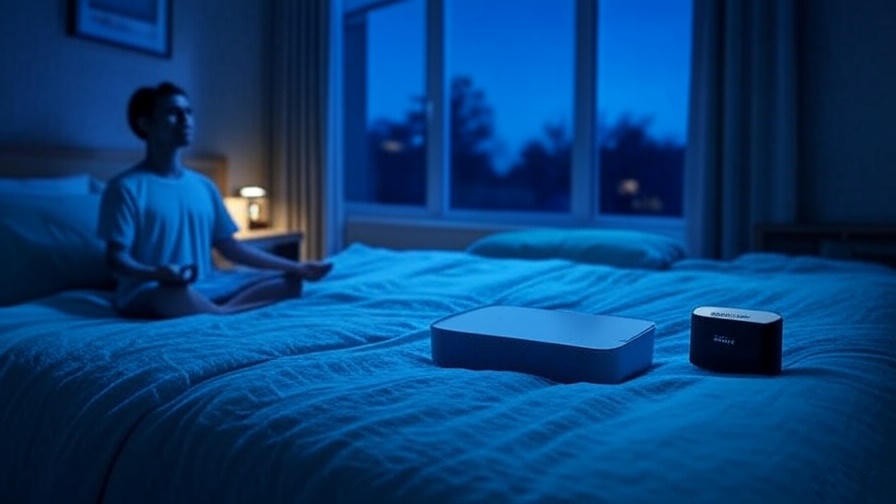Did you know that stress-related illnesses cost the global economy over $1 trillion annually, while the mindfulness industry is projected to reach $9 billion by 2027? In this era of burnout and anxiety, Headspace stock represents more than just a financial opportunity—it’s a chance to invest in a movement transforming mental health. As a leading meditation and wellness app, Headspace has revolutionized how millions approach mindfulness, sleep, and holistic well-being. This article explores whether investing in Headspace stock can align your financial goals with personal wellness, offering actionable insights for those intrigued by the intersection of wealth and well-being.
By diving into Headspace’s market impact, financial potential, and the science behind mindfulness, we’ll uncover how this company fits into the booming wellness industry and why it’s catching investors’ attention. Whether you’re a seasoned investor or a mindfulness enthusiast, this guide will help you navigate the opportunities and challenges of Headspace stock while enhancing your personal well-being through practical mindfulness strategies.
Section 1: Understanding Headspace and Its Market Impact
What Is Headspace and Why It Matters
Headspace, founded in 2010 by former Buddhist monk Andy Puddicombe and marketing expert Richard Pierson, is a digital health platform that democratizes mindfulness and mental health support. Available on iOS, Android, and web platforms, Headspace offers guided meditations, sleep aids, and mental health coaching, making it a cornerstone of the digital wellness revolution. With over 70 million downloads and a presence in 190 countries, Headspace has become synonymous with accessible mental health care. Its user-friendly app provides sessions on stress, sleep, focus, and anxiety, backed by 40 peer-reviewed studies validating its efficacy.
Headspace’s mission is to make meditation relevant and beneficial for everyone. From its early days as a London-based event company to its current status as a global leader, Headspace has evolved into a comprehensive mental health platform. Its 2021 merger with Ginger, a mental health coaching service, valued the combined entity at $3 billion, signaling its growing influence.
Expert Insight: Dr. Megan Jones Bell, former Chief Science Officer at Headspace, notes, “Mindfulness apps like Headspace are grounded in evidence-based practices that reduce stress and improve emotional regulation, making them vital tools for modern mental health.”
The Rise of the Wellness Industry

The global wellness industry is a juggernaut, valued at over $1.5 trillion and growing at a compound annual growth rate (CAGR) of 5-10%. Digital health platforms, particularly meditation apps, are driving much of this growth. The U.S. meditation market alone is expected to reach $2.08 billion by 2022, with mobile mindfulness apps projected to grow at an 8.5% CAGR through 2029.
Headspace thrives in this landscape through its subscription-based model, offering premium content for $12.99/month or $69.99/year after a 14-day free trial. Its B2B arm, Headspace for Work, partners with over 4,000 employers, including Google and Starbucks, to provide mindfulness programs that boost employee productivity and well-being. For example, Aetna reported a 62-minute weekly productivity gain per employee using Headspace, translating to $3,000 in annual savings per employee.
Headspace’s competitive edge lies in its blend of consumer and enterprise offerings. Unlike rivals like Calm, which focuses heavily on direct-to-consumer strategies, Headspace’s partnerships with health plans like Cigna and organizations like Accolade expand its reach. Its recent ventures, like the mindfulness-based VR game Headspace XR for Meta Quest, further showcase its innovation.
Section 2: Headspace Stock – A Financial Perspective
Is Headspace Publicly Traded?
As of September 2025, Headspace remains a privately held company under Headspace Health, with no public stock available. However, its $320.9 million in funding across 13 rounds, including a $105 million debt financing in 2023, has fueled speculation about a potential initial public offering (IPO). Investors like Oxford Finance LLC, Spectrum Equity, and The Chernin Group have backed Headspace, reflecting confidence in its growth. The 2021 Headspace-Ginger merger, valued at $3 billion, further bolstered its financial standing.
While no IPO has been confirmed, Headspace’s strategic moves—such as acquiring Shine and Sayana to enhance inclusive and AI-driven mental health tools—suggest it’s positioning for scalability. Investors can currently access Headspace stock through private marketplaces like EquityZen, UpMarket, or Forge Global, but this is limited to accredited investors.
Why Investors Are Eyeing Headspace Stock
Headspace’s appeal lies in its alignment with the surging demand for mental health solutions. The global mental health crisis, exacerbated by the COVID-19 pandemic, has increased anxiety and depression rates by over 25%, per The Lancet. This has driven demand for digital platforms like Headspace, which offers meditation, coaching, therapy, and psychiatry services. Its revenue streams include subscriptions, corporate partnerships, and healthcare integrations, reducing reliance on any single channel.
For example, Headspace’s work with Blue Shield of California demonstrates its ability to navigate 80% of members to self-care content, reducing the need for costly live therapy sessions. Its enterprise offerings, like the next-generation Employee Assistance Program (EAP), provide in-person clinical care and substance use disorder support, making it a versatile player in the health tech space.
Example: Starbucks’ adoption of Headspace for Work resulted in improved employee engagement, with 74% of participants reporting higher work satisfaction.
Tip: To stay informed about a potential Headspace IPO, use platforms like Crunchbase or Bloomberg to track funding rounds and news. Setting up Google Alerts for “Headspace IPO” can ensure you don’t miss updates.
Risks and Considerations
Investing in Headspace stock, especially pre-IPO, carries risks. The wellness app market is competitive, with players like Calm ($2 billion valuation) and Ten Percent Happier vying for market share. Free meditation resources on platforms like YouTube could also erode paid subscriptions. Economic downturns may reduce consumer spending on non-essential apps, and Headspace’s recent layoffs (15% of its workforce in 2023) signal cost-cutting efforts amid profitability challenges.
Expert Insight: Financial analyst Sarah Thompson of Morningstar cautions, “Health tech investments like Headspace are promising but volatile. Investors must weigh market saturation and execution risks against growth potential.”
Section 3: The Connection Between Mindfulness and Wealth
How Mindfulness Boosts Financial Decision-Making
Mindfulness, the practice of staying present and non-judgmental, can transform financial decision-making. Research from the University of Cambridge shows that mindfulness reduces impulsive behaviors by 30%, helping investors avoid rash decisions like chasing “hot” stocks or panic-selling during market dips. Headspace’s guided meditations, such as its “Mindful Money” collection, help users confront financial stress, reframe spending habits, and cultivate clarity.

For instance, a 10-minute Headspace meditation before reviewing your portfolio can calm anxiety, enabling more rational choices. By training the mind to focus on long-term goals, mindfulness counters emotional biases like fear or greed, which Jonathan DeYoe, author of Mindful Investing, notes lead to costly mistakes.
Example: Sarah, a 35-year-old investor, used Headspace’s “Confronting Debt” course to manage financial anxiety. By practicing daily mindfulness, she reduced impulsive spending and developed a clear debt repayment plan, saving $5,000 in a year.
Can Investing in Wellness Stocks Improve Personal Well-Being?
Investing in companies like Headspace aligns financial decisions with personal values, a concept known as impact investing. This approach fosters a sense of purpose, reducing stress and enhancing well-being. A 2020 study by the Global Impact Investing Network found that 88% of impact investors reported higher satisfaction with their portfolios, as their investments reflected their commitment to social good.
Headspace’s focus on mental health makes it an attractive option for those prioritizing wellness. By supporting a company that improves lives, investors may feel a psychological boost, reinforcing their commitment to mindfulness practices.
Tip: Explore other wellness-focused investments, such as Teladoc Health or the Global X Telemedicine & Digital Health ETF, to diversify your portfolio while supporting health innovation.
Section 4: Practical Steps for Investors Interested in Headspace
How to Prepare for a Potential Headspace IPO
While Headspace stock isn’t publicly traded, investors can prepare for a potential IPO by taking proactive steps:
- Research Private Market Opportunities: Platforms like EquityZen, UpMarket, and Nasdaq Private Market allow accredited investors to buy pre-IPO shares. For example, UpMarket estimates Headspace’s share price at $0.92 based on a $230.39 million valuation, though this is speculative.
- Track Funding and News: Monitor Headspace’s funding rounds and acquisitions on Crunchbase or Bloomberg. Its $105 million debt financing in 2023 suggests ongoing growth plans.
- Set Alerts: Use Google Alerts or financial news apps to stay updated on IPO rumors or Headspace Health announcements.
- Consult a Financial Advisor: Work with an expert to assess pre-IPO risks and align investments with your goals.
Tip: Join investment forums like Reddit’s r/investing to discuss Headspace stock and gain insights from other investors.
Alternative Ways to Invest in the Mindfulness Industry

If Headspace stock is inaccessible, consider these alternatives:
- Publicly Traded Wellness Companies: Invest in companies like Teladoc Health (TDOC), which offers telehealth services, or WW International (WW), focused on holistic wellness.
- ETFs: The Global X Telemedicine & Digital Health ETF (EDOC) includes health tech companies, providing diversified exposure to the sector.
- Other Meditation Apps: While Calm is also private, keep an eye on its potential IPO, as it’s valued at $2 billion.
Example: The EDOC ETF has grown 12% annually, offering a low-risk way to tap into the digital health trend without betting on a single company.
Section 5: Maximizing Personal Well-Being with Headspace
How to Use Headspace for Holistic Wellness

Headspace offers a versatile toolkit for integrating mindfulness into daily life, addressing stress, sleep, and emotional balance. Whether you’re a busy professional, a student juggling deadlines, or a parent managing a hectic household, Headspace’s features can be tailored to your needs. Here’s a practical guide to getting started:
- Morning Meditation: Begin your day with Headspace’s “Daily Wake Up” series, a 5–10-minute guided meditation to set a positive tone. These sessions focus on gratitude and intention-setting, helping you approach the day with clarity.
- Stress Management: Use the “Managing Stress” course, which includes visualizations and breathing exercises to reduce anxiety. For example, the “Letting Go of Stress” meditation uses body scans to release tension.
- Sleep Support: Headspace’s “Sleepcasts” and “Sleep Sounds” feature soothing narratives and ambient sounds to improve sleep quality. The “Nighttime SOS” sessions are ideal for those waking up at 3 a.m. with racing thoughts.
- Focus and Productivity: Try the “Focus Mode” for guided sessions that enhance concentration during work or study. These are particularly useful for professionals facing high-pressure deadlines.
For parents, Headspace offers kid-friendly content like “Sleepy Stories” to help children wind down. Students can benefit from the “Studying & Focus” collection, which supports sustained attention during exam prep. Professionals can access Headspace for Work through employer programs, often at no cost.
Tip: Create a daily mindfulness routine by scheduling 10 minutes in the morning for meditation and 5 minutes at night for a sleep-focused session. Consistency is key—studies show that 21 days of daily meditation can significantly reduce stress hormones like cortisol.
The Science Behind Headspace’s Effectiveness
Headspace’s approach is rooted in science, with over 40 peer-reviewed studies validating its impact on mental health. A 2020 study in The Journal of Medical Internet Research found that Headspace users experienced a 14% reduction in anxiety after just two weeks of daily use. Another study from Frontiers in Psychology showed that 10-minute daily meditations improved sleep quality by 22% and emotional regulation by 18%.
The app leverages mindfulness-based stress reduction (MBSR) and cognitive behavioral therapy (CBT) principles, blending them into accessible formats. For example, Headspace’s “Reframing Anxiety” course uses CBT techniques to help users identify and challenge negative thought patterns. Its sleep-focused content aligns with research showing that mindfulness improves REM sleep and reduces insomnia symptoms.
Expert Insight: Dr. Judson Brewer, a neuroscientist and mindfulness expert, explains, “Apps like Headspace work by training the brain’s prefrontal cortex to regulate emotions, reducing reactivity to stressors. This creates a ripple effect, improving sleep, focus, and overall well-being.”
Example: Lisa, a 42-year-old teacher, struggled with insomnia for years. After using Headspace’s “Sleepcasts” for a month, she reported falling asleep 15 minutes faster and waking up refreshed, which improved her classroom performance.
Section 6: FAQs
Q: Is Headspace stock available to buy now?
A: As of September 2025, Headspace is not publicly traded. It operates under Headspace Health, a private company valued at $3 billion after its 2021 merger with Ginger. Investors can explore pre-IPO shares through platforms like EquityZen, but these are limited to accredited investors. Monitor financial news for IPO updates.
Q: How does Headspace compare to competitors like Calm?
A: Headspace and Calm both offer guided meditations and sleep aids, but Headspace stands out with its B2B focus, serving over 4,000 employers. Headspace’s pricing ($12.99/month) is comparable to Calm’s ($14.99/month), but its therapy and psychiatry services via Ginger give it an edge in comprehensive mental health care. Calm, however, excels in celebrity-narrated content, appealing to pop culture fans.
Q: Can mindfulness really improve financial decisions?
A: Yes, research supports this. A 2021 study in Behavioral Finance found that mindfulness practices reduce impulsive spending by 25% and improve long-term investment planning. Headspace’s “Mindful Money” course helps users address financial stress, fostering rational decision-making.
Q: What are the risks of investing in wellness companies?
A: Wellness companies face risks like market saturation, competition from free resources, and economic downturns affecting consumer spending. Headspace’s recent layoffs (15% in 2023) highlight profitability challenges. Investors should diversify and consult financial advisors to mitigate risks.
Conclusion
Investing in Headspace stock represents a unique opportunity to align your financial portfolio with your personal wellness goals. While Headspace is not yet publicly traded, its $3 billion valuation and innovative mental health solutions make it a compelling prospect for investors eyeing the $1.5 trillion wellness industry. Beyond financial returns, using Headspace’s app can enhance your well-being by reducing stress, improving sleep, and sharpening financial decision-making. Start small—try Headspace’s 14-day free trial to experience its benefits, and set up alerts on platforms like Bloomberg to stay informed about a potential IPO.
By blending mindfulness with strategic investing, you can cultivate a healthier, wealthier future. As the world prioritizes mental health, Headspace stands at the forefront, offering both personal transformation and financial promise. Take the first step today: meditate, invest wisely, and watch your well-being and wealth grow in harmony.













